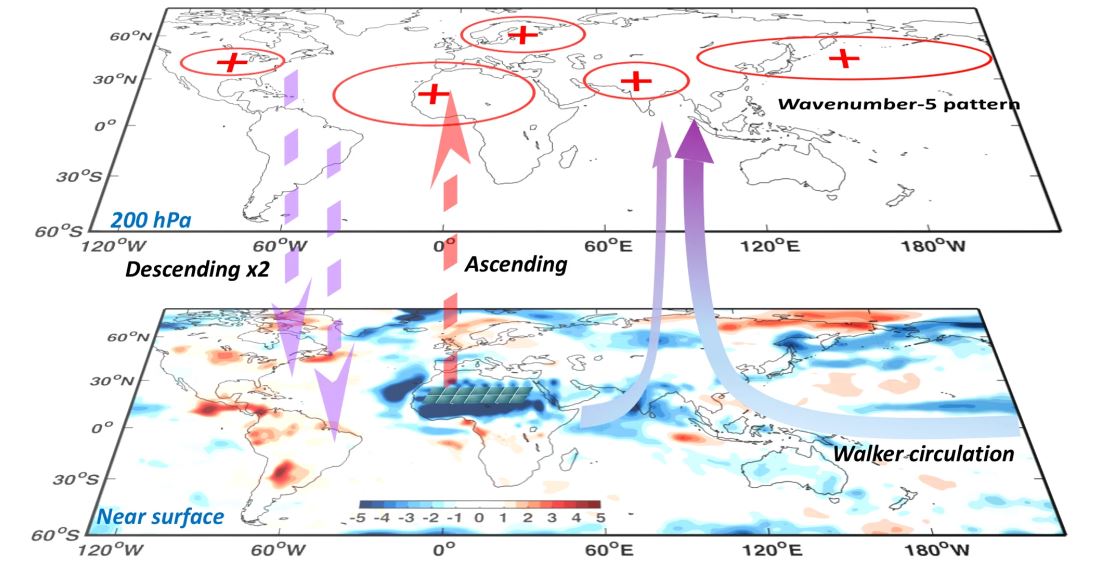An international research team has investigated the potential impact of deploying photovoltaic solar farms in the Sahara Desert on atmospheric circulation and global cloud cover in an effort to estimate potential issues arising from changes in land surface properties.
The scientists sought to demonstrate that solar farms deployed in the Sahara may result in atmospheric circulation changes and perturbations to the global cloud fraction and surface downward shortwave radiation (RSDS), which is the sum of the incoming solar energy over the earth's surface in the shortwave spectrum.
The academics explained that solar plants in arid regions may amplify regional climate response through local atmosphere-land and vegetation feedback processes. “In North Africa, reduced surface albedo and feedbacks trigger localized warming and convection,” they stated. “This leads to surface convergence, and subsequently a positive geopotential height and divergence at the upper troposphere over North Africa.”
The scientists considered three different scenarios in which the Sahara desert is covered by solar plants with percentages of 5%, 20%, and 50%. It conducted a series of simulations via the Earth system model (EC-Earth), which simulates the physical, chemical, and biological processes that govern the Earth system, at different levels of complexity.
“EC-Earth reasonably reproduces several key dynamic processes relevant to this study, such as the atmospheric general circulation and monsoon system, atmospheric teleconnections, and clouds in the tropics and the mid-latitudes over land,” they said.
Through their analysis, the researchers found that the 5% scenario may see a “limited significant” regional climate response over North Africa and the Sahel region, while the 20% scenario may see a larger impact reaching Southern Europe and the Southern Arabian Peninsula.
Popular content
The 50% scenario will be that with the largest impact, with the increased annual mean cloud fraction reaching also India, North Asia, and Eastern Australia. “Conversely, decreased cloud cover is observed over Central and South America, South Africa, Central & Eastern United States, Central Asia and Northwestern China,” the scientists stressed.
They presented their modeling in the paper “Large-scale photovoltaic solar farms in the Sahara affect solar power generation potential globally,” published in communications earth & environment. “More in-depth analyses and sensitivity simulations considering various scenarios combined with multiple Earth system models which overcome these limitations can shed more light on the impacts of this particular anthropogenic land use and land cover change,” they concluded.
The research group comprised researchers from the Guangdong Ocean University, the Tsinghua University and the Nanjing University of Information Science and Technology in China, the Lund University and the Stockholm University in Sweden, the Ludwig Maximilian University of Munich, and the Western Sydney University in Australia.
This content is protected by copyright and may not be reused. If you want to cooperate with us and would like to reuse some of our content, please contact: editors@pv-magazine.com.



By submitting this form you agree to pv magazine using your data for the purposes of publishing your comment.
Your personal data will only be disclosed or otherwise transmitted to third parties for the purposes of spam filtering or if this is necessary for technical maintenance of the website. Any other transfer to third parties will not take place unless this is justified on the basis of applicable data protection regulations or if pv magazine is legally obliged to do so.
You may revoke this consent at any time with effect for the future, in which case your personal data will be deleted immediately. Otherwise, your data will be deleted if pv magazine has processed your request or the purpose of data storage is fulfilled.
Further information on data privacy can be found in our Data Protection Policy.